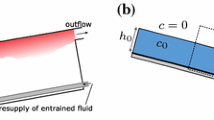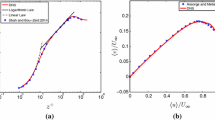Abstract
The interaction of an internal gravity wave with its evolving critical layer and the subsequent generation of turbulence by overturning waves are studied by three-dimensional numerical simulations. The simulation describes the flow of a stably stratified Boussinesq fluid between a bottom wavy surface and a top flat surface, both without friction and adiabatic. The amplitude of the surface wave amounts to about 0.03 of the layer depth. The horizontal flow velocity is negative near the lower surface, positive near the top surface with uniform shear and zero mean value. The bulk Richardson number is one. The flow over the wavy surface induces a standing gravity wave causing a critical layer at mid altitude. After a successful comparison of a two-dimensional version of the model with experimental observations (Thorpe [21]), results obtained with two different models of viscosity are discussed: a direct numerical simulation (DNS) with constant viscosity and a large-eddy simulation (LES) where the subgrid scales are modelled by a stability-dependent first-order closure. Both simulations are similar in the build-up of a primary overturning roll and show the expected early stage of the interaction between wave and critical level. Afterwards, the flows become nonlinear and evolve differently in both cases: the flow structure in the DNS consists of coherent smaller-scale secondary rolls with increasing vertical depth. On the other hand, in the LES the convectively unstable primary roll collapses into three-dimensional turbulence. The results show that convectively overturning regions are always formed but the details of breaking and the resulting structure of the mixed layer depend on the effective Reynolds number of the flow. With sufficient viscous damping, three-dimensional turbulent convective instabilities are more easily suppressed than two-dimensional laminar overturning.
Similar content being viewed by others
References
Andreassen, Ø, Wasberg, C.E., Fritts, D.C. and Isler, J.R., Gravity breaking in two and three dimensions. 1. Model description and comparison of two-dimensional evolutions.J. Geophys. Res. 99 (1994) 8095–8108.
Booker, J.R. and Bretherton, F.P., The critical layer for internal gravity waves in a shear flow.J. Fluid Mech. 27 (1967) 513–539.
Delesi, D.P. and Dunkerton, T.J., Laboratory observations of gravity wave critical-layer flows.Pure Appl. Geophys. 130 (1989) 445–461.
Dörnbrack, A. and Schummann, U., Numerical simulation of turbulent convective flow over wavy terrain.Bound. Layer Meteorol. 65 (1993) 323–355.
Eliassen, A. and Palm, E., On the transfer of energy in stationary mountain waves.Geofysiske Publikasjoner XXXII (1960) 1–23.
Fritts, D.C., Isler, J.R. and Andreassen, Ø, Gravity breaking in two and three dimensions. 2. Three-dimensional evolution and instability structure.J. Geophys. Res. 99 (1994) 8109–8123.
Koop, C.G. and McGee, B., Measurements of internal gravity waves in a continuously stratified shear flow.J. Fluid Mech. 172 (1986) 453–480.
Kaltenbach, H.-J., Gerz, T. and Schumann, U., Large-eddy simulation of homogeneous turbulence and diffusion in stably stratified shear flow.J. Fluid Mech. 280 (1994) 1–40.
Krettenauer, K. and Schumann, U., Numerical simulation of turbulent convection over wavy terrain.J. Fluid Mech. 237 (1992) 261–299.
Lilly, D.K., On the numerical simulation of buoyant convection.Tellus 14 (1962) 148–172.
Nappo, C.J. and Chimonas, G., Wave exchange between the ground surface and a boundary-layer critical level.J. Atmos. Sciences 49 (1992) 1075–1091.
Nastrom, G.D. and Eaton, F.D., The coupling of gravity waves and turbulence at White Sands, New Mexico, from VHF radar observations.J. Appl. Meteorol. 32 (1993) 81–87.
Maaß, C. and Schumann, U., Numerical simulation of turbulent flow over a wavy boundary. In: Voke, P.R., Kleiser, L. and Chollet, J.P. (eds),Direct and Large-Eddy Simulation I. Dordrecht: Kluwer Academic Publishers (1994) pp. 287–297.
Merrill, J.T. and Grant J.R., A gravity wave — Critical level encounter observed in the atmospere.J. Geophys. Res. 84 (1979) 6315–6320.
Pao, Y. and Goldburg, A. (eds),Clear Air Turbulence and Its Detection. New York: Plenum Press (1969).
Sato, K. and Woodman, R.F., Fine altitude resolution radar observations of stratospheric layers by the Arecibo 430 MHz radar.J. Atmos. Sciences 39 (1982) 2546–2552.
Schumann, U., Hauf, T., Höller, H., Schmidt, H. and Volkert, H., A mesoscale model for the simulation of turbulence, clouds and flow over mountains: Formulation and validation examples.Contr. Atmos. Phys., Beitr. Phys. Atmos. 60 (1987) 413–446.
Sidi, C., Waves-turbulence coupling. In: Thrane, E.V. et al. (eds),Coupling Processes in the Lower and Middle Atmosphere. Dordrecht: Kluwer Academic Publishers (1993) pp. 291–304.
Smith, R.B., The influence of mountains on the atmosphere.Adv. in Geophysics 21 (1979) 87–230.
Thorpe, S.A., A method of producing a shear flow in a stratified fluid.J. Fluid Mech. 32 (1968) 693–704.
Thorpe, S.A., An experimental study of critical layers.J. Fluid Mech. 103 (1981) 321–344.
Author information
Authors and Affiliations
Rights and permissions
About this article
Cite this article
Dörnbrack, A., Gerz, T. & Schumann, U. Turbulent breaking of overturning gravity waves below a critical level. Appl. Sci. Res. 54, 163–176 (1995). https://doi.org/10.1007/BF00849114
Received:
Accepted:
Issue Date:
DOI: https://doi.org/10.1007/BF00849114




